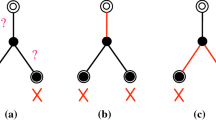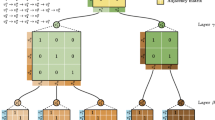Abstract
Traffic matrix (TM) plays an important role in many network engineering and management tasks. However, the accurate TM estimation is still a challenge because the problem is highly under-constrained. In this paper, we propose a considerably accurate approach, termed as Tomofanout, for the estimation of TM in large-scale IP network using the available link load data, routing matrix, and partial direct measurement data of TM. Firstly, we propose an edge link fanout model which defines each edge link’s fanout, i.e., each edge link’s fractions of traffic emitting from that edge link to other edge links. Secondly, benefited from the edge link fanout’s diurnal pattern and stability, we are able to compute the edge link baseline fanout to estimate the TM at the following days by multiplying it by the edge link loads at the corresponding time intervals. In such way, an initial link-to-link TM estimation result is calculated by the edge link fanout model. Further, by making the corresponding transformation to the link-to-link TM, the router-to-router TM estimation result is thus obtained. Thirdly, the solution is then refined by the basic model of the Tomography method to keep consistent with both the edge and the interior link loads for further improvement of accuracy in estimation. In particular, the expectation maximization (EM) iteration of the basic model of Tomography method is used for further refinement. As the iteration is running on, the edge link fanout model solution is gradually approaching to the final estimation result, which is compatible with both the edge and the interior link loads. Fourthly, a general algorithm is proposed for computing the edge link baseline fanout and the estimation of the TM. Finally, the Tomofanout approach is validated by simulation studies using the real data from the Abilene Network. The simulation results demonstrate that Tomofanout achieves extremely high accuracy: its spatial relative error (SRE) is less than one half of Tomogravity’s, while its temporal relative error (TRE) is less than one half of Fanout’s and is only one third of Tomogravity’s.








Similar content being viewed by others
References
Zhang Y, Roughan M, Duffield N, Greenberg A (2003) Fast accurate computation of large-scale IP traffic matrices from link loads. ACM SIGMETRICS Perform Eval Rev 31:206–217
Papagiannaki K, Taft N, Lakhina A (2004) A distributed approach to measure IP traffic matrices. In: Proceedings of the ACM SIGCOMM conference on internet measurement, pp 161–174
Soule A, Lakhina A, Taft N, Papagiannaki K, Salamatian K, Nucci A, Crovella M, Diot C (2005) Traffic matrices: balancing measurements, inference and modeling. In: Proceedings on ACM SIGMETRICS ’05, vol 33, No 1, pp 362–373
Adams A, Bu T, Aceres RC, Duffield N, Friedman T, Horowitz J, Presti FL, Moon S, Paxson V, Towsley D (2000) The use of end-to-end multicast measurements for characterizing internal network behavior. IEEE Commun Mag 38:152–159
Cao J, Davis D, Wiel SV, Yu B (2000) Time-varying network tomography. J Am Stat Assoc 95:1063 C 1075
Coates M, Hero A, Nowak R, Yu B (2002) Internet tomography. IEEE Signal Proc Mag
Tebaldi C, West M (1998) Bayesian inference on network traffic using link count data. J Am Stat Assoc 93:557–576
Vardi Y (1996) Network tomography: estimating source-destination traffic intensities from link data. J Am Stat Assoc 91:365–377
Dempster AP, Laird NM, Rubin DB (1977) Maximum likelihood from incomplete data via the EM algorithm. J Royal Stat Soc 39:1–38
McLachlan G, Krishnan T (1996) The EM algorithm and extensions. Wiley
McLachlan G, Peel D (2000) Finite mixture models. Wiley-Interscience
Vardi Y (1996) Applications of the EM algorithm to linear inverse problems with positivity constraints. Image models (and their speech model cousins), pp 183–198
Medina A, Taft N, Salamatian K, Bhattacharyya S, Diot C (2002) Traffic matrix estimation: existing techniques and new directions. In: Proc. ACM SIGCOMM ’02, vol 32, No 4. Pittsburgh, pp 161–174
Kowalski J, Warfield B (1995) Modeling traffic demand between nodes in a telecommunications network. ATNAC
Lam D, Cox D,Widom J (1997) Teletraffic modeling for personal communications services. In: IEEE commun magazine: special issues on teletraffic modeling engineering and management in wireless and broadband networks, vol 35, pp 79–87
Medina A, Fraleigh C, Taft N, Bhattacharyya S, Diot C (2002) A taxonomy of IP traffic matrices. SPIE ITCOM: scalability and traffic control in IP networks II. Boston, USA
Pyhnen P (1963) A tentative model for the volume of trade between countries. Weltwirtschaftliches Archive, vol 90, pp 93–100
Roughan M, Greenberg A, Kalmanek C, Rumsewicz M, Yates J, Zhang Y (2002) Experience in measuring backbone traffic variability: models, metrics, measurements and meaning (extended abstract). ACM SIGCOMM Internet Measurement Workshop
Tinbergen J (1962) Shaping the world economy: suggestions for an international economic policy. The Twentieth Century Fund
Soule A, Salamatian K, Nucci A, Taft N (2005) Traffic matrix tracking using kalman filters. ACM SIGMETRICS Perform Eval Rev 33(3):24–31
Lakhina A, Papagiannaki K, CrovellaM, Diot C, Kolaczyk E, Taft N (2004) Structural analysis of network traffic flows. In: Proceedings on ACM SIGMETRICS ’04, vol 32, No 1. New York, pp 61–72
Liang G, Taft N, Yu B (2006) A fast lightweight approach to origin-destination IP traffic estimation using partial measurements. IEEE Trans Inf Theory 52(6):2634–2648
Jiang D, Jun C, Linbo HE (2007) An accurate approach of large-scale IP traffic matrix estimation. IEICE Trans Commun 90(12):3673–3676
Nie L, Jiang D, Guo L (2013) A power laws-based reconstruction approach to end-to-end network traffic. J Netw Comput Appl 36(2):898–907
Nie L, Jiang D, Xu Z (2013) A compressive sensing-based reconstruction approach to network traffic. Comput Electr Eng 39(5):1422–1432
Wang Z, Hu K, Xu K, Yin B, Dong X (2012) Structural analysis of network traffic matrix via relaxed principal component pursuit. Comput Netw 56(7):2049–2067
He LB, Liu L, Sheng ZW (2013) Research of network traffic matrix based on improved fanout model. Appl Mech Mater 321:2745–2748
Tan L, Wang X (2007) A novel method to estimate IP traffic matrix. IEEE Commun Lett 11(11):907–909
Tan L, Wang X (2007) On IP traffic matrix estimation. In: Proceedings on the 16th international conference on computer communication and networks (ICCCN 2007). Honolulu, pp 617–624
Caggiani L, Dell’Orco M, Marinelli M, Ottomanelli M (2012) A metaheuristic dynamic traffic assignment model for OD matrix estimation using aggregate data. Procedia-Soc Behav Sci 54:685–695
Djukic T, Flotterod G, Lint HV, Hoogendoorn S (2012) Efficient real time OD matrix estimation based on principal component analysis. In: Proceedings on the 15th international ieee conference on intelligent transportation systems (ITSC), pp 115–121
Tchrakian TT, Basu B, Mahony MO (2012) Real-time traffic flow forecasting using spectral analysis. Intell Transp Syst 13:519–526
Fang J, Vardi Y, Zhang C (2007) An iterative tomogravity algorithm for the estimation of network traffic. Inst Math Stat 54:12–23
Zhang Y. Datasets: www.cs.utexas.edu/%7Eyzhang/research/AbileneTM/
Corbato S, Summerhill R. The abilene network topology: www.internet2.edu/presentations/spring03/20030410-Abilene-Corbato.pdf.
Author information
Authors and Affiliations
Corresponding author
Additional information
The work described in this paper was supported by a grant from the National Natural Science Foundation of China (Nos. 61070197, 61370107) and grants from the self-determined research funds of CCNU.
Rights and permissions
About this article
Cite this article
Tan, L., Zhou, H. Tomofanout: a novel approach for large-scale IP traffic matrix estimation with excellent accuracy. Ann. Telecommun. 70, 149–158 (2015). https://doi.org/10.1007/s12243-014-0431-x
Received:
Accepted:
Published:
Issue Date:
DOI: https://doi.org/10.1007/s12243-014-0431-x




